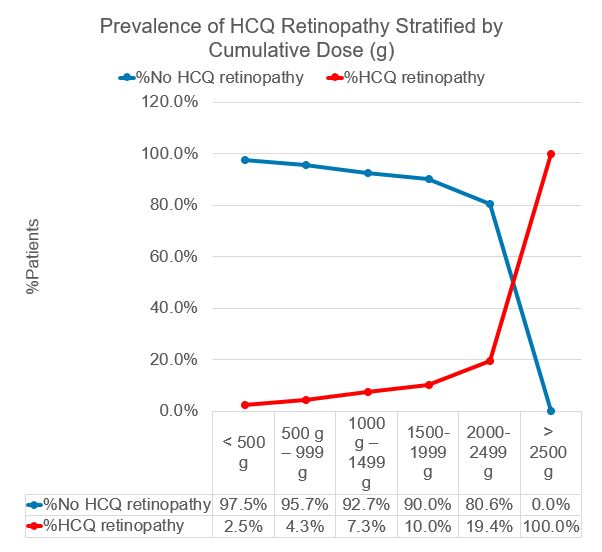Session Information
Session Type: Poster Session A
Session Time: 9:00AM-11:00AM
Background/Purpose: Hydroxychloroquine (HCQ) is commonly used for the treatment of various autoimmune diseases. The medication is generally well-tolerated. However, long-term use after 5 years may increase the risk of retinopathy. One study in 2014 has demonstrated the risk can be as high as 7.5%. Optical Coherence Tomography (OCT) has become a major modality in screening retinopathy. Our study is to evaluate the prevalence of retinal toxicity among patients using HCQ and to determine various risk factors associated with HCQ-associated retinal toxicity.
Methods: We performed a retrospective chart review on a cohort of adult patients with long-term use ( > 5 years cumulative) of HCQ between January 1st, 2011 to December 31st, 2018 from the Kaiser Permanente San Bernardino County and Riverside Medical Center areas in Southern California, USA. Patients were excluded if they had previous been diagnosed with retinopathy prior to HCQ use, were deceased, or had incomplete OCT exam. Our primary endpoint was the prevalence of patients who developed retinal toxicity detected by OCT, and later confirmed by retinal specialist. Potential risk factors (age, duration of therapy, daily consumption per actual body weight, cumulative dose, confounding diseases and medications) for developing retinopathy were also evaluated. Univariable and multivariable logistic regression analyses were used to determine risk factors associated with retinal toxicity.
Results: Among 676 patients exposed to more than 5 years of HCQ, the overall prevalence of retinal toxicity was 6.8%, and ranged from 2.5% to 22.2% depending on the age group, weight-based dosing, duration of use and cumulative dose. Duration of therapy for 10 years or more increased risk of retinopathy by approximately 5 to 19 folds. Similarly, weight-based dose of 7mg/kg/day or greater was associated with increased risk of retinopathy by approximately 5 times. Patients with cumulative dose of 2000 grams or more had greater than 15 times higher risk of developing retinopathy. Duration of use for 10 years or more (odd ratio 4.32, 95% CI 1.99-12.49), age (odd ratio 1.04; 95% CI 1.01-1.08), cumulative dose of more than 1500 grams(odd ratio 7.4; 95% CI 1.40-39.04) and atherosclerosis of the aorta (odd ratio 2.59; 95% CI, 1.24-5.41) correlated with higher risk of retinal toxicity.
Conclusion: The overall prevalence of retinopathy was 6.8%. Routine OCT screening, especially in patient with hydroxychloroquine use for more than 10 years, daily intake > 7 mg/kg, or cumulative dose > 1500 grams is important in detecting HCQ-associated retinal toxicity.
Results: HCQ Treatment Dosage, Duration, and Cumulative Dose
Results: Cumulative Dose of HCQ Therapy Distribution
To cite this abstract in AMA style:
Do S, Du J, An J, Wang J, Lin A. The Prevalence and Risk Factors of Retinal Toxicity Associated with Long-term Hydroxychloroquine Use [abstract]. Arthritis Rheumatol. 2023; 75 (suppl 9). https://acrabstracts.org/abstract/the-prevalence-and-risk-factors-of-retinal-toxicity-associated-with-long-term-hydroxychloroquine-use/. Accessed .« Back to ACR Convergence 2023
ACR Meeting Abstracts - https://acrabstracts.org/abstract/the-prevalence-and-risk-factors-of-retinal-toxicity-associated-with-long-term-hydroxychloroquine-use/


